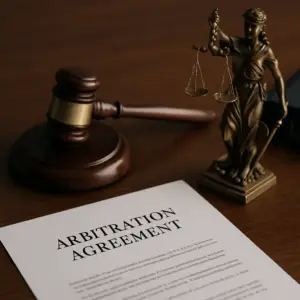How Large Companies Resolve Internal Conflict Efficiently
October 1, 2025
Share Article:
Settling disputes with our online arbitration services is easy, fast, and affordable.
We look forward to answering your questions and helping you to reach conflict resolution with our online arbitration service.

Handling Non-Compete Violations Without Going to Court
A non-compete agreement is a type of restrictive covenant commonly found in an employment contract. Employers often require employees to sign these contracts to prevent job hopping, safeguard trade secrets, and protect client relationships. At their core,

Arbitration vs. Litigation in Texas: A Cost Comparison
For Texas businesses facing legal disputes, selecting the right dispute resolution mechanism is a critical decision. Two common options are arbitration and litigation, each with distinct advantages, challenges, and cost implications.

How Freelancers Can Use Arbitration to Settle Payment Disputes
Freelancing offers freedom, flexibility, and the opportunity to shape your own career—but it also comes with risks. Chief among them? Clients who don’t pay. Whether you’re a graphic designer waiting on a final invoice or a developer facing payment disputes over

Commercial Arbitration Services in Los Angeles: What Businesses Need to Know
Los Angeles is home to one of the most sophisticated and dynamic business communities in the country. From startup founders to private equity funds and insurance companies, businesses in this region increasingly rely on alternative dispute

Is Arbitration Legally Binding? Understanding the Fine Print
If you’ve ever signed a contract for a job, a credit card, or even a cell phone plan, chances are you’ve agreed to arbitration—maybe without even realizing it. But is arbitration legally binding? And what does that actually mean for you as a consumer? Understanding
Why efficient conflict resolution matters in enterprise settings
In large organizations, conflict is inevitable. Cross-functional priorities clash, communication styles differ, and resources are finite. Handled well, conflict resolution can accelerate problem solving, improve employee engagement, and strengthen team dynamics. Handled poorly, it undermines organizational productivity, damages workplace harmony, and invites costly turnover. Mature conflict management systems give leaders clear options before issues escalate into formal complaints or court proceedings. Research-grounded practices from leadership institutes and applied organizational psychology show that conflict management is a teachable, measurable capability that scales across business units, geographies, and remote environments.
The anatomy of workplace conflict: interpersonal and structural
Most internal conflict falls into two buckets:
- Interpersonal conflict between team members, often driven by misaligned expectations, cognitive dissonance, or competing incentives.
- Structural conflict embedded in roles and responsibilities, workflows, or governance. When escalation paths are unclear or decision rights are split, the structure itself creates friction.
Clinical overviews describe conflict as a difference in goals or perceptions that becomes harmful if unmanaged, and highlight that successful conflict management seeks outcomes that benefit both the individuals and the group. Recognizing the type of conflict allows leaders to select the right remedy, from facilitated dialogue to redesigning a process that repeatedly triggers disputes.
Root causes in large organizations
Internal conflict typically concentrates around a few themes:
- Communication breakdowns. Information asymmetry across divisions and time zones produces conflicting interpretations of priorities.
- Ambiguous roles and responsibilities. Overlaps between product, sales, and operations fuel conflict escalation, especially during rapid growth.
- Competition for resources. Budget cycles and headcount allocations create friction when objectives outpace capacity.
- Cultural differences. Global organizations must navigate communication styles, decision speed, and hierarchy norms without eroding inclusion or belonging.
- Remote and hybrid dynamics. Digital communication tools help, but absence of body language cues can amplify misunderstandings that would dissolve in a face-to-face meeting. Practical guidance from executive education emphasizes proactive prevention through norms, explicit decision rules, and shared project management systems.
Build a scalable conflict management system
Large enterprises resolve conflict efficiently by designing Peacebuilding Systems inside the organization rather than relying on ad hoc heroics. A robust system includes:
- A clear policy and pathway. Documented conflict resolution and dispute resolution procedures with tiers of intervention: self-service resources, manager-led conversations, HR or People Business Partner facilitation, then formal mediation or internal arbitration if needed. Public-sector guidance on alternative dispute resolution provides a useful, neutral model for cooperative problem solving that many private employers adapt.
- Defined roles. Managers trained to run early interventions; HR specialists who coach; neutral third-party facilitators for sensitive or high-stakes matters.
- Standard clause language. Agreements, charters, and leadership compacts that point to informal dispute resolution before formal complaints.
- Documentation discipline. Brief conflict summaries, agreed action items, and follow-up times that keep momentum without creating legal jargon.
- Confidentiality boundaries. Clear rules about what is private, what must be documented, and when to escalate to compliance or legal counsel.
The role of leadership: set tone, skill, and metrics
Leaders legitimize conflict management by modeling calm, curiosity, and fair process. Several leadership frameworks place conflict management alongside coaching and communication as core competencies for senior roles. U.S. federal leadership criteria, for example, explicitly include conflict management within the “Leading People” qualification, encouraging constructive disagreement and timely resolution. Practical leadership guidance highlights structured steps: set the stage, describe the conflict, gain perspective, seek agreement, and identify next steps with accountability. Tracking leadership metrics such as 360 surveys, time-to-resolution, and re-occurrence rates makes progress visible.
Skill building at scale: training, coaching, and practice
Conflict resolution training builds shared language and communication skills across team members. Effective programs teach leaders and contributors to recognize triggers, separate positions from interests, read body language, and use peaceful communication techniques in feedback sessions. Step-by-step guidance from leadership institutes and business schools suggests treating parties equally, giving each side time to speak, and guiding toward collaboration or compromise. Coaching reinforces these skills for high-visibility workplace situations and remote environments where video conference dynamics differ from in-person dialogue.
An 8-step enterprise playbook for conflict management
To translate policy into daily practice, many organizations adopt a common workflow. This playbook is designed for large teams, but scales down for small to mid-sized businesses:
- Signal capture. Encourage early reporting of friction by normalizing quick check-ins rather than waiting for formal complaints.
- Rapid triage. A manager or designated neutral identifies the conflict type, stakes, and any compliance risks.
- Preparation. Each side writes a short statement of goals and non-negotiables. Data is gathered from shared project management systems to ground the conversation.
- Facilitated dialogue. In a confidential setting, the facilitator sets norms, surfaces interests, and ensures balanced airtime.
- Option generation. The group co-creates alternatives that align with roles and responsibilities and the organizational culture.
- Mutual agreement. Parties select a solution, define owners and dates, and document what “done” looks like.
- Follow-through. A brief written summary is circulated. Managers schedule a check-in to review progress and adjust.
- Learning loop. HR or Operations logs themes for organizational analysis, improving training strategy, staffing, or policies.
These steps mirror research-backed advice that breaks difficult conversations into predictable phases so leaders can repeat the process consistently across teams.
Remote and hybrid realities: tune the channel, then the message
Distributed teams must adapt conflict management strategies to digital communication tools. Practical guidance stresses choosing the right channel for the moment: start async when issues are low-stakes, shift to a face-to-face meeting or video conference if tone is misread, and reserve written recaps to lock clarity. Leaders should confirm understanding out loud, avoid sarcasm or ambiguous emojis, and watch for time-zone fatigue that can be mistaken for disengagement. Executive education sources highlight preventive norms like clear agendas, turn-taking protocols, and visible decision logs to reduce conflict escalation in dispersed teams.
When to use internal mediation or external neutrals
Even strong managers encounter conflicts that require a neutral third party. Internal mediation brings in trained facilitators who are independent of the reporting lines. For highly sensitive disputes, organizations may retain external neutrals to protect confidentiality and minimize bias. Alternative dispute resolution handbooks emphasize cooperative problem solving as a “first resort” when polarization is still low, and reserve formal investigations or legal action for issues involving misconduct, discrimination, or policy breaches.
Governance, compliance, and fair process
Efficient systems integrate compliance without turning every disagreement into a legal matter. HR toolkits recommend explicit escalation criteria, consistent documentation, and coaching for managers to handle most conflicts at the level they occur. Public-sector resources offer reference materials and performance-management tool kits that align conflict resolution with broader accountability systems without sacrificing due process. Private employers can adapt these templates to keep conflict management connected to performance, safety, and ethics.
Quick answers to People Also Ask
What are the 5 C’s of conflict resolution?
Different models exist, but common C’s include clarity, curiosity, candor, compassion, and commitment. The spirit matches leadership guidance that urges setting the stage, describing issues, gaining perspective, and agreeing on next steps.
What are the 5 conflict resolution strategies?
Classic approaches include collaborating, compromising, competing, accommodating, and avoiding. Clinical and management sources emphasize choosing a style based on stakes, time, and relationships.
What are effective strategies for resolving conflict at work?
Treat parties equally, create psychological safety, listen actively, and steer toward collaboration or principled compromise. Use structured steps and follow-through to prevent repeat flare-ups. Harvard Business School OnlineCCL
How might businesses prevent workplace conflict?
Set clear roles and decision rights, train managers in conflict management, establish escalation paths, and adopt meeting norms that fit remote and hybrid teams. Harvard Executive Development
Final takeaway for large organizations
Efficient conflict management is not a single workshop. It is an enterprise capability that blends policy, leadership behaviors, communication skills, and fair process. Large companies that document pathways, upskill managers, use neutral facilitation when needed, and close the loop with metrics resolve internal conflict faster and with less collateral damage. That protects culture, preserves business relationships, and keeps
Recent Posts

Handling Non-Compete Violations Without Going to Court
A non-compete agreement is a type of restrictive covenant commonly found in an employment contract. Employers often require employees to sign these contracts to prevent job hopping, safeguard trade secrets, and protect client relationships. At their core,

Arbitration vs. Litigation in Texas: A Cost Comparison
For Texas businesses facing legal disputes, selecting the right dispute resolution mechanism is a critical decision. Two common options are arbitration and litigation, each with distinct advantages, challenges, and cost implications.

How Freelancers Can Use Arbitration to Settle Payment Disputes
Freelancing offers freedom, flexibility, and the opportunity to shape your own career—but it also comes with risks. Chief among them? Clients who don’t pay. Whether you’re a graphic designer waiting on a final invoice or a developer facing payment disputes over

Commercial Arbitration Services in Los Angeles: What Businesses Need to Know
Los Angeles is home to one of the most sophisticated and dynamic business communities in the country. From startup founders to private equity funds and insurance companies, businesses in this region increasingly rely on alternative dispute

Is Arbitration Legally Binding? Understanding the Fine Print
If you’ve ever signed a contract for a job, a credit card, or even a cell phone plan, chances are you’ve agreed to arbitration—maybe without even realizing it. But is arbitration legally binding? And what does that actually mean for you as a consumer? Understanding

